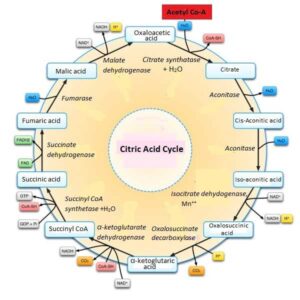Citric acid cycle consists of number of reactions which produce NADH and FADH₂ and then they are used by the oxidative phosphorylation pathway to make ATP which then passes through the electron transport system. The citric acid cycle happens in the matrix of the mitochondria of the cell. The oxydation of pyruvic acid takes place through a series of reaction. These reactions produced through a cycle known as tricarboxylic acid cycle. It is also known as TCA cycle. The first product in this cycle is cytric acid hence it is called the citric acid cycle or CAC.
British biochemist Sir Hans Adolf Krebs discovered this cycle in 1937. As a result he awarded the Nobel Prize in 1953. Accordingly this cycle also familiar as Kreb`s cycle.
Important Features of Citric Acid Cycle
- It helps in the cellular respiration.
- It happens inside the mitochondria and it is restricted to only aerobic respiration.
- It occurs in cyclic pathway which is regulated by a specific enzyme.
- This cycle does not consume any ATP molecules.
- Two ATP/GTP, eight NADH2, two FADH2 and six CO2 molecules are produced in the citric acid cycle.
Key Citric Acid Cycle Enzymes
- Citrate synthase
- Aconitase
- Isocitrate dehydogenase
- Oxalosuccinate decarboxylase
- α-Ketoglutarate dehydrogenase
- Succinyl Co-A synthatase
- Fumarase
- Malate dehydrogenase
Key Intermediates
Following key intermediates are produced from the citric acid cycle:
- Cytric acid (citrate)
- Isocitrate
- Cis-aconitic acid
- Cis-aconitic acid
- Oxalosuccinic acid
- α-ketoglutaric acid
- Succinyl-CoA
- Succinic acid (succinate)
- Fumaric acid (Fumarate)
- Malic acid (Malate)
- Oxaloacetic acid (Oxaloacetate)
Steps of Cytric Acid Cycle
Kreb`s cycle or citric acid cycle is an oxidation process which occurs stepwise. In this case, it includes four dehydogenase steps and two decarboxylation steps. It produces reduced co-enzymes and CO2.
Pyruvic acid is formed through the process of glycolysis in cell cytoplasm. After formation of pyruvic acid, it enters into the mitochondria. In the presence of six factors such as Mg++, NAD, TPP (Thiamine pyrophosphate), lipoic acid, FAD and coenzyme A, the pyruvic dehydogenase along with enzyme complex converts pyruvate to acetyle CoA.

Overall steps of citric acid cycle are described below:
Step-1: The first step is the condensation step. In this step, acetyle CoA mix with oxaloacetate and H2O in the presence of condensing enzymes citratrate synthetage and produce one molecule of citric acid. After reaction CoA is released out. In this case, acetyl CoA is two carbon molecule, oxaloacetate is 4 carbon molecule while cytric acid or citrate is 6 carbon molecule.

Step-2: It is the isomirization step. In this step, cytric acid is converted into its isomer isocitrate by completing the following two step reactions with the help of aconitase enzyme.
(i) Dehydration: In this case, one molecule of H2O is released out and citric acid is converted into cis-aconitic acid.

(ii) Rehydration: In this case, cis-aconitic acid joins with one molecule of H2O and produce isocitric acid.

Step-3: The third step is the dehydrogenation step. In this step, isocitrate /isocitric acid is dehydrogenated into oxalosuccinic acid by losing 2H– with the help of isocitrate dehydrogenase enzyme and Mn++. The enzyme isocitrate dehydrogenase catalyzes this step and this enzyme is responsible to regulate the speed of the citric acid cycle. During this step, NAD (Nicodinamide adenine dinucleotide) is reduced and forms NADH2.


Citric Acid Cycle
Step-4: The fourth step is the decarboxylation step. In this step, oxalosuccinic acid is decarboxylated into α-ketoglutaric acid by losing CO2 with the help of enzyme, oxalosuccinate decarboxylase.

Step-5: It is oxidative decarboxylation step where α-ketoglutaric acid undergoes dehydrogenation and decarboxylation at the same time with the help of enzyme, ketoglutarate dehydrogenase. The enzyme, ketoglutarate dehydrogenase catalyzes and it is responsible for regulating the speed of the citric acid cycle. In this step, NAD+, Mg++, and CoA are required. Finally, succinyl CoA, NADH2 and CO2 are produced.

Step-6: It is the substrate level GTP or ATP synthesis step. In this step succinyl CoA is synthesized into succinic acid with the help of enzyme, succinyl-CoA synthatase. It is energy liberated step and during this step, one molecule of molecule of GTP is produced and CoA is released.

Step-7: This step is also known as dehydrogenation step. In this step, succinic acid is dehydrogenated into four-carbon molecule fumaric acid in the presence of succinate dehydrogenase enzyme. In this case, hydrogen is given out by succinic acid and is picked up by FAD(Flavin adenine dinucleotide) to form FADH2.

Step-8: In this step, fumaric acid is converted into a 4 carbon molecule malic acid. In this case, fumaric acid reacts with one molecule of H2O in the presence of enzyme fumarase.

Step-9: In this step, malic acid is dehydrogenated into oxaloacetic acid in the presence of malate dehydogenase enzyme. In this reaction, NAD+ is reduced to form NADH2.

Oxaloacetic acid again joins with acetyle CoA and again begins a new citric acid cycle. The oxidative catabolism of pyruvate can be shown in the following equation:

Citric Acid Cycle Products
The citric acid cycle involves 2 pyruvic acids from which the following products may be summarized:
- Total number of reduced co-enzyme molecules= 8 NADH2 and 2 FADH2
- Total number of ATP produced directly= 2ATP
- Total number of CO2 molecules released= 6CO2
- Total number H2O utilized= 6H2O
Significance of Citric Acid Cycle
- Trough the citric acid cycle, carbon skeletom is produced that helps in growth; it also maintains the cells.
- During the citric acid cycle, various intermediate compounds are formed. These help in the synthesis of nucleotides, amino acids, fats, chlorophyll, and cytochromes, etc.
- In this cycle, succinyl CoA is produced which is essential for the formation of pigment like chlorophyll.
- In cytric acid cycle, α-ketoglutaric acid, pyruvic acids and oxaloacetic acid are produced respectively which take part in the production of amino acids.
- In this cycle, many ATPs are produced which take part in the different metabolic acitivites of the cells.
